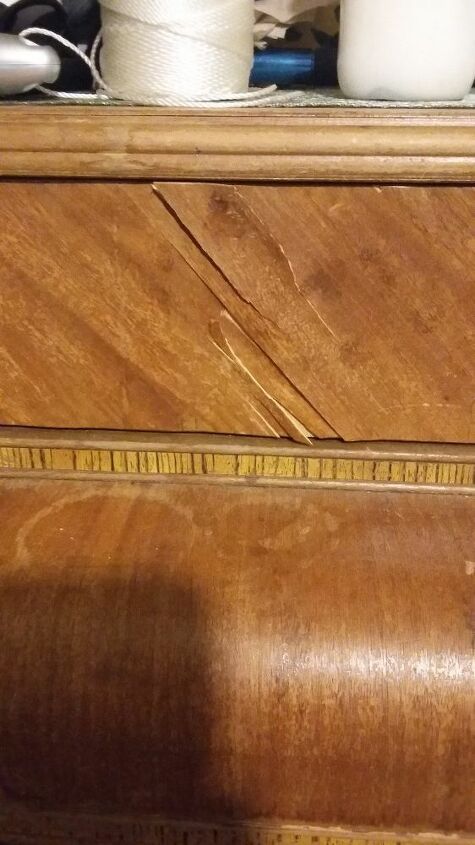How do I fix the veneer on my dresser?

by
Laurie Ewing
(IC: )
+11
Answered
Related Discussions
How to get rid of mice?
We seem to have some unwelcome Mickeys and Minnies in our house. What is the best way to get rid of them?
336
See Answers
How to remove popcorn ceiling with asbestos?
I want to remove my popcorn ceiling, but it has asbestos in it. How do I go about this safely?
66
See Answers
How to caulk baseboard gaps?
How do I fill gaps at baseboard, should I caulk? If so, does anyone know how to caulk baseboards?
47
See Answers
How to fix squeaky hardwood floors?
How do I fix squeaky hardwood floors?
33
See Answers
How do I fix my cracked carpet liner for my office chair?
How do I fix peeling vinyl from my bathroom vanity..a piece was ripped
Suggested Project Book
© 2024 Hometalk.com
By Hometalk Inc.






Peel it off abd replace it.
I would use a small amount of wood glue under the piece that is coming off and use wood putty to make the rest smooth. Once it is smooth it is ready for painting if you are wanting to paint!
Looks like it got wet. Peel back loose veneer and use a flat piece of cardboard to work some wood glue under it. Flatten out as best you can. Wipe off excess glue. Get a wood block a little larger than your repair, put a piece of wax paper between the block and repair and clamp it down to flatten it tight. Let dry over night. Remove block and paper. Lightly sand off any glue smooth out. Touch up finish.
This can be done, but it will be a bit of a labor of love. The veneer strip is entirely removed (scraper), clean all residue, replace veneer (easily purchased and you can bleach it yourself - not household bleach). You could even use an entirely different wood species for contrast. Side note: consider a good oiling or waxing of your wood piece. 🌷
I'm going to try Kelli's idea! Thanks for everyone's help!
Good Day if you are missing veneer you can buy veneer it comes in rolls, take a piece of paper and place it on the area that is missing on the dresser and rub your pencil over it so you get the outline shape of the missing area, now you have the shape you need to cut out and glue back in, glue and place something heavy on it till it is dry. If your existing veneer is curled, use a damp towel, place it on the area, use your iron on a hot steam and press the area till it lays flat, I will lay something heavy on the area till it dries to see if I have to repeat the process, remember to sand lightly to remove any glue that seeps around the edges, stain does not stick to glue, FYI some veneer comes with a sticky back, so no glue required. When steaming the curled bits, the damp and heat reactivate the existing glue you may need to apply a bit of wood glue to the edges with a small brush. Good Luck it is a real easy fix, have fun.
Actually, another way to get the glue under the lifting vaneer is to get a syringe with a wide opening on the needle end, fill the syringe with wood glue and then syringe it underneath the lifting veneer, pushing down the veneer and weighting it to hold it down while the adhesive sets. Take care to make sure the edges line up and you should be able to make relatively seamless repairs. You can also use a fine exacto blade or razor to lift off any of the wood glue that has leaked from the repaired seams after it has dried without damaging the surface of the veneer.
Peel back as much as possible and coat both sides with rubber cement. Use a hair dryer to speed the process. When tacky to the touch, press back on and use a rubber mallet to secure in place. This is the process cabinet refacing pros use.
I took the buckled veneer off the top of an old English dresser (soaked it with water). Low and behold found beautiful oak with worm holes under the veneer. I sanded and stained the oak to match the dresser. My husband, not a fan of this dresser, bragged to everyone on how beautiful it turned out.
Your lucky, you can glue it down and fix it. Mine has a 2 foot jagged rip angled across the top by a moving company. Too deep to fill and fix.